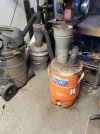- Joined
- Jun 3, 2019
- Messages
- 2,714
Well ... the answer is kind of all the above. The dust deputy came about because my original setup had that weird right angle turn to convert the downward flow from the grinder into the horizontal inlet to the dust deputy. I ended up finding out that both metal dust and wood dust collect in the bottom of that turn. Needs to be cleaned out and is a fire hazard ... especially if I go from wood to metal without cleaning the thing. So, the dust deputy just now exists.I think the idea is to eliminate anything that could be hot before it reaches the actual vacuum.
That way you can have an expensive filter (hepa) at the end that is really only filtering super fine stuff at the end, and it will last a lot longer. Not to mention be more effective.
But I could be wrong, maybe cushing just likes Rube Goldberg machines...
Right now I am thinking kind of what AMcpherson said ... I have it, so why not use it ... doing so will provide extra protection from sparks or water making it to the shop vac (and I do have a hepa in there) .... and I REALLY do not want a fire. The cost is airflow. For now I will see how it goes..



